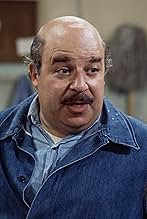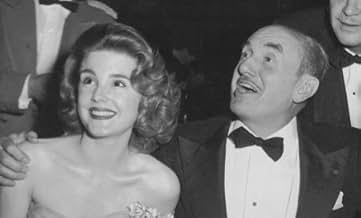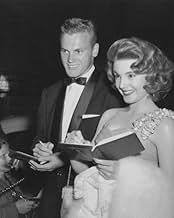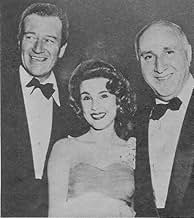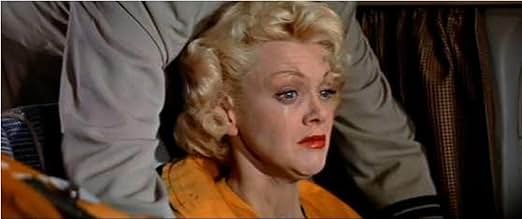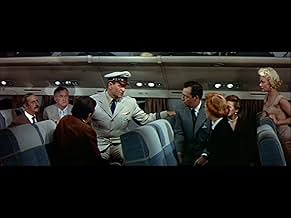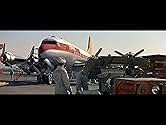Ein Verkehrsflugzeug auf einem Trans-Pazifik-Flug bekommt Triebwerksprobleme und der Pilot verliert die Nerven. Nun liegt es an dem abgewrackten Co-Piloten Dan Roman, das Flugzeug sicher ins... Alles lesenEin Verkehrsflugzeug auf einem Trans-Pazifik-Flug bekommt Triebwerksprobleme und der Pilot verliert die Nerven. Nun liegt es an dem abgewrackten Co-Piloten Dan Roman, das Flugzeug sicher ins Ziel zu bringen.Ein Verkehrsflugzeug auf einem Trans-Pazifik-Flug bekommt Triebwerksprobleme und der Pilot verliert die Nerven. Nun liegt es an dem abgewrackten Co-Piloten Dan Roman, das Flugzeug sicher ins Ziel zu bringen.
- 1 Oscar gewonnen
- 5 Gewinne & 7 Nominierungen insgesamt
- Gonzales
- (as Gonzalez Gonzalez)
Empfohlene Bewertungen
The Wayne Family in general, and I would assume sons Michael and Patrick in particular, own the film along with some others. One has to wonder why they do not release it. I have a copy I recorded from HBO many years ago and when aired it was a great print. I am fortunate to be able to see it now and then at my own leisure.
The plot of a crippled airliner in the middle of the Pacific doesn't accurately describe this film. It is a true character study with some of the finest actors of the day on hand delivering brilliant performances. Those that stand out include Jan Sterling (oscar nominee and Golden Globe winner), Claire Trevor (Oscar nominated), Phil Harris, Robert Newton, and David Brian. But each and every one in the rest of the cast can take a bow for a job well done. And That includes Wayne himself. His Dan Roman is complete, a man with strengths and weaknesses, but a man who eventually is the only one to step up in a time of crisis. It is one of his best performances.
William Wellman's direction keeps the film moving, Dimitri Tiomkin's Oscar winning score had viewers whistling along with Whistling Dan.
Mike and Pat, please let this one out before it becomes an antique. A new generation of your father's fans await this classic. It is not fair to deny them their chance to see him. And by the way. John Wayne was not the original choice to play Dan Roman. When He acquired the rights to the film he just wanted to produce it ( a la Bullfighter and the Lady). His choice wanted to play the role, but schedule conflicts prevented this, thus John Wayne had to play the role he offered to Spencer Tracy
Produced by Wayne-Fellows Productions, and 'owned', eventually, by the Wayne family's Batjac Productions (along with "Hondo", "McLintock!", and "Island in the Sky"), the film was a BIG hit, when released, and offered one of Wayne's better performances, then gained even greater stature as it was unseen for a generation. I've always held the belief that the family planned to release the entire quartet of films in 2007, to mark the centennial of Duke's birth, but two events changed the plan; first, an unauthorized, 'remixed' VHS version of "McLintock!" was released, with rumors that a version of "Hondo" was also in the works, forcing Michael Wayne, then President of Batjac, to release authorized VHS versions of the two films, rather than have the market glutted with bad copies; second, with Michael's death, in 2003, the Wayne family rethought the master plan, deciding to release the entire collection on DVD earlier. For whatever reason, seeing "The High and the Mighty" again is a cause to celebrate!
Based on Ernest K. Gann's bestseller (which would inspire Arthur Hailey's later novel, "Airport"), the story centers around a routine commercial flight between Honolulu and San Francisco, which becomes a life-and-death drama when one engine explodes, just beyond the 'Point of No Return'. With limited fuel, in deteriorating weather, the crisis brings out the best and worst in both passengers and crew.
Wayne as the co-pilot, is quite good, playing a character older than he actually was (the role had been written for Spencer Tracy, who pulled out, just prior to filming); Robert Stack almost foreshadows his character in "Airplane!" as the no-nonsense pilot who goes ballistic when stressed. For cockpit 'overacting', however, the award has to go to Wally Brown, as the navigator, with his bugged-out eyes, visions of his shrewish wife, and WILDLY unruly hair...
While the passengers are all stereotypes, several actors are quite good in their roles, with standout performances by Claire Trevor and Jan Sterling (both Oscar-nominated), Robert Newton, Paul Kelly, and Paul Fix. While Phil Harris attempts to inject humor into his role, it only works sporadically (and Ann Doran, as his wife, plays 'hysterical' so convincingly that you want to STRANGLE her!) Laraine Day, third-billed (and, with Trevor, a previous Wayne leading lady), is remarkably unlikable as a rich wife with a 'bought' husband (John Howard); Sidney Blackmer plays the 'mandatory' unbalanced type; and veteran character actor John Qualen adds another 'ethnic' portrayal to his long list, as a Latin family man (with a Norwegian accent!) A bit of trivia: The young boy on board was portrayed by director Wellman's son!
Almost as fascinating as the story is seeing how much has changed, since the film was released; the plane's 'tail' is controlled by pulleys and wires in a rear compartment; the sole flight attendant is a "stewardess"; and everyone smokes (especially in the cockpit). On a more somber note, there is NO security, and one passenger boards easily, carrying a gun. It is, sadly, a wiser world, today...
While no one would ever accuse "The High and the Mighty" of being a film classic, it's role in creating the 'airplane disaster' genre can't be denied, and it continues to be a vastly enjoyable John Wayne feature.
It's great to have it back!
I can remember when I was in high school in the '60s some ten years after the movie was released (I have never seen it since) and Mr. Marcellino was a guest at one of our assemblies and demonstrated his amazing versatility at whistling and even performed the letters of the alphabet as an example of how he had mastered his craft. His range was phenomenal as he portrayed the instruments of the orchestra and then performed the entire Rhapsody in Blue as well as popular works all by whistling without accompaniment, but admitted that the theme for TH&TM was his proudest achievement. The Academy of Motion Picture Arts and Sciences has never recognized the contributions of all musical forms to the success of pictures as gauged from their mention in passing at the annual telecast Oscar ceremonies, but if they had, this singular performance would have been guaranteed a Special Oscar. Truly, once it is heard, neither it nor the film can ever be forgotten, but will haunt one for years to come! This classic film is the fitting epitaph for Messrs. Wayne, Tiomkin, and Marcellino. Would that we all could be remembered for such an achievement.
As some have speculated, there's no way for this film to live up to the hype that has grown up because of its near-forty year unavailability. It's been beautifully restored. The picture quality seems to my uneducated eye to be impeccable, and the sound is really magnificent. And there are some moments of nice performance, particularly by Wayne, Robert Stack, Jan Sterling, and John Qualen. But as much as I would love to say this is a resurrected masterpiece, it simply isn't possible for me to do so honestly. After AIRPLANE!, I'm not sure it's reasonable to expect people to take a Fifties airliner disaster movie seriously. But the level of corn and hokum and treacle and syrup in which the film wallows (especially in the primary sections dealing with the passengers rather than the crew) is simply intolerable in today's world. I'm not referring to the fact that it's a different practical world now, one in which it would be ludicrous to show a passenger pulling a gun on another passenger on an airliner of today. I'm referring rather to the simple unbelievability of the human behavior exhibited. I'm willing to accept a passenger getting aboard a trans-Pacific airliner with a gun in his pocket in 1954. I'm not willing to accept him pulling that gun, threatening other passengers with it, having it taken from him, and later having it handed back to him just because he says, "I'm all right now, I've calmed down." Phil Harris, fifty at the time and looking sixty, plays a 38-year-old, and 43-year-old Ann Doran plays his 30-year-old wife. Laraine Day berates her husband and demands a divorce, and good ol' Phil says to the husband, "You think you got problems?" and proceeds to tell him about how rain and crummy hotels ruined his vacation, and the husband (John Howard) thus sees his own life in a new perspective. Every cliché imaginable comes into play, and rarely is there a moment that can be easily swallowed, even with Herculean efforts to place oneself mentally in the zeitgeist of the film.
Only in the cockpit are things comparatively realistic and believable, and even there big pills must be swallowed. One of the reasons John Wayne comes off so well in this film is he has relatively little to say. It's probably the lowest line-count of any of Wayne's leading roles, and thus unsaddled with the maudlinities and sappiness of the dialog the passengers are stuck with, he comes off better than anyone in the picture. Spencer Tracy was supposed to play Wayne's role but turned it down (according to various stories) either because he thought the script was lousy or he didn't want to work for taskmaster William Wellman. I'm betting on the former reason.
There are still things to like in THE HIGH AND THE MIGHTY (Dimitri Tiomkin's Oscar-winning score among them), but an awful lot of people have been waiting forty years to see this "masterwork" again, and an awful lot of them are going to be either seriously disappointed or forced to convince themselves that it's not as bad as it seems.
In the early 50s, people were just getting used to the idea that they could climb aboard a big man-made eagle and soar above cars, buses, and trains. It was a thrilling, but scary, idea, not unlike traveling on the Titanic. And so, with "The High And The Mighty", Hollywood created the first big budget movie that conveyed the idea of risk, in commercial air travel. Throughout the film, the overriding emotion is insecurity, not only among passengers but among the crew as well. Since the film was a cinematic prototype, I can see how its nerve-wracking story would appeal to moviegoers of that era. The film's angelic theme music thus provided inspiration to help viewers overcome their fear of something new and different, something potentially life threatening.
Since the early 50s, air travel has lost its sense of adventure. The film to us seems quaint and dated. What seemed odd to me, for example, was the ticket counter. The pace was leisurely, and the attention was very personal. Then, on board the plane, the stewardess made sure that the passengers got personalized attention. At one point, even the captain, upon request, reassured a nervous passenger. Those were the days.
First time viewers also need to be aware that this film is talky and dreamily melodramatic. The emphasis is on story and acting, not special effects or high-powered action. And then there is that final Act. It is different perhaps from what most of us probably would expect. But again, we must take into account the era in which the film was made.
Fifty years after its release, "The High And The Mighty", as a film, cannot compete with its own theme music. The sweeping orchestration, like music generally, transcends time and spans the generations. By contrast, technology, and mankind's reaction to technology, changes. The film's story thus has a different meaning to us than it did to the original moviegoers. If you can place the film in its proper historic context, you have a better chance of appreciating the film for what it was then, not for what it is now.
Wusstest du schon
- WissenswertesErnest Gann's novel clearly indicates that the character of Sally McKee has resorted to prostitution in order to survive. The film version, made at the height of Hollywood censorship, was unable to explicitly state this; however, Gann slyly managed to insinuate the information during Sally's entrance, wherein two sailors at the Honolulu airport recognize her and pointedly remark, "Hey, look! Remember?"
- PatzerNear the end of the film, Air Traffic Control clears the aircraft to land on "runway 39" This is impossible. Runways are numbered are within 10 degrees of their actual magnetic heading, and since there are only 360 degrees on the compass, the highest runway number possible is "runway 36".
- Zitate
Alsop: She may be put together with paste and flour, but that woman has something. What would you say it was?
Miss Spalding: Practice. Plenty of practice.
- Alternative VersionenThe song "The High and the Mighty" (with lyrics) does not appear in the original 1954 release of this film. However, the studio wanted the hugely popular, chart-topping song to be nominated for the Best Song Academy Award that year. According to AMPAS regulations, the song could not be nominated because it was no officially sung in the film, even if would be heard elsewhere. To satisfy these regulations, a version was released towards the tail-end of 1954 for a few nights only with the song inserted into an Exit Music. The Academy then decided to give the song a nomination on the basis of these screenings. The song lost to "Three Coins in a Fountain".
- VerbindungenEdited into Geheimagent des FBI (1959)
Top-Auswahl
- How long is The High and the Mighty?Powered by Alexa
Details
Box Office
- Budget
- 1.470.000 $ (geschätzt)
- Weltweiter Bruttoertrag
- 4.334 $
- Laufzeit2 Stunden 27 Minuten
- Sound-Mix
- Seitenverhältnis
- 2.55 : 1


